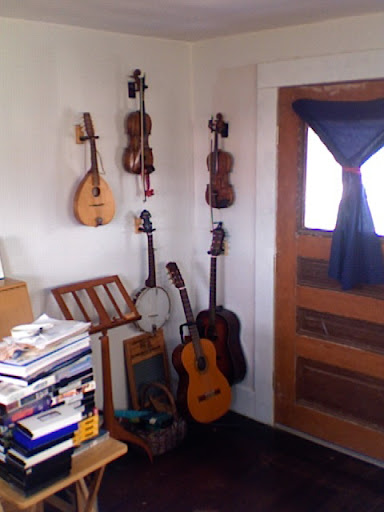"What's the difference between a violin and a fiddle?",
"No one cries when they spill beer on a fiddle."
a Wiki on the subject:
A violin is sometimes informally called a fiddle, regardless of the kind of music being played with it. The word "violin" is derived from Italian and the word "fiddle" is native to English. The two words are etymologically related, both ultimately deriving from the same Germanic word.[1]
Historically, the word fiddle also referred to a predecessor of today's violin. Like the violin, it tended to have four strings, but came in a variety of shapes and sizes. Another family of instruments which contributed to the development of the modern fiddle are the viols, which are held between the legs and played vertically, and have fretted fingerboards.
One very slight difference between "fiddles" and ordinary violins may be seen in American (e.g., bluegrass and old-time music) fiddling: in these styles, the top of the bridge may be cut so that it is very slightly less curved. This reduces the range of right-arm motion required for the rapid string-crossings found in some styles, and is said to make it easier to play double stops and shuffles (bariolage), or to make triple stops possible, allowing one to play chords.
Most classical violinists prefer a more rounded curve to the top of the bridge, which allows them to articulate each note more easily and clearly. In practice, most instruments are fitted with a rounded bridge to better accommodate the shape of the fingerboard. (One exception is the 3-string kontra or bracsa, a viola used in Hungarian and Transylvanian folk music fitted with a flat bridge to allow all three strings to be played simultaneously.) In any case, the difference between "round" and "flat" is not great; about a quarter or half a millimeter variation in the height of one or two strings. As a violin's bridge is relatively easy to replace, modifying the bridge does not permanently make a violin into a fiddle.
It is also more common to see an instrument described as a fiddle if it has steel strings rather than gut or synthetic, and fine tuners on all four strings; it is very uncommon to see four fine tuners on instruments played by classical musicians. (Fine tuners are small screw mechanisms attached to the tailpiece, which make small tuning adjustments easier.) As with the bridge, this configuration is easy to change from "violin" to "fiddle", and causes no irreversible changes to the instrument.
In construction, fiddles and violins are exactly the same. Various clichés describe the difference: "When you are buying it, it's a fiddle. When you are selling it, it's a violin," "The violin sings, the fiddle dances," "A fiddle is a violin with attitude," or, in answer to the musical joke, According to Branson performer Shoji Tabuchi, the difference lies "in how you fiddle around with it." As might be expected from the differences between classical and folk music, violinists tend to be formally trained and fiddlers tend to be informally trained, although crossing over is not uncommon.
















